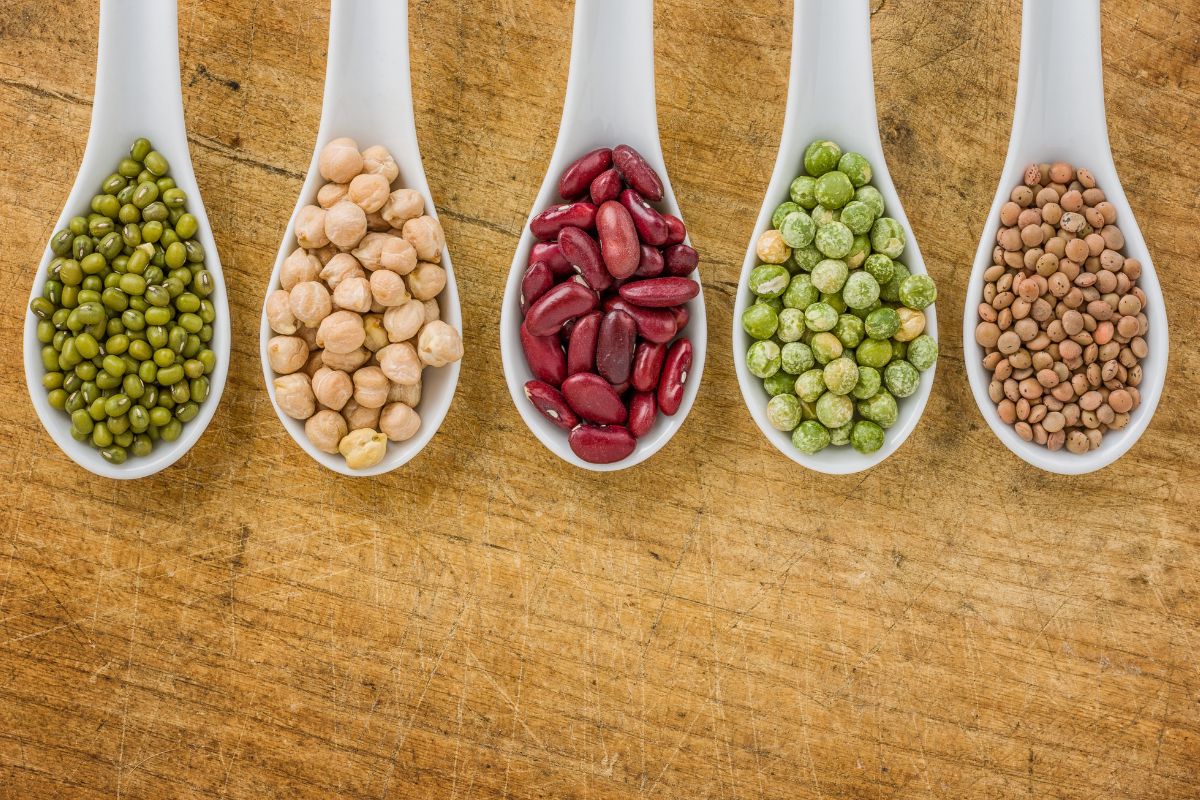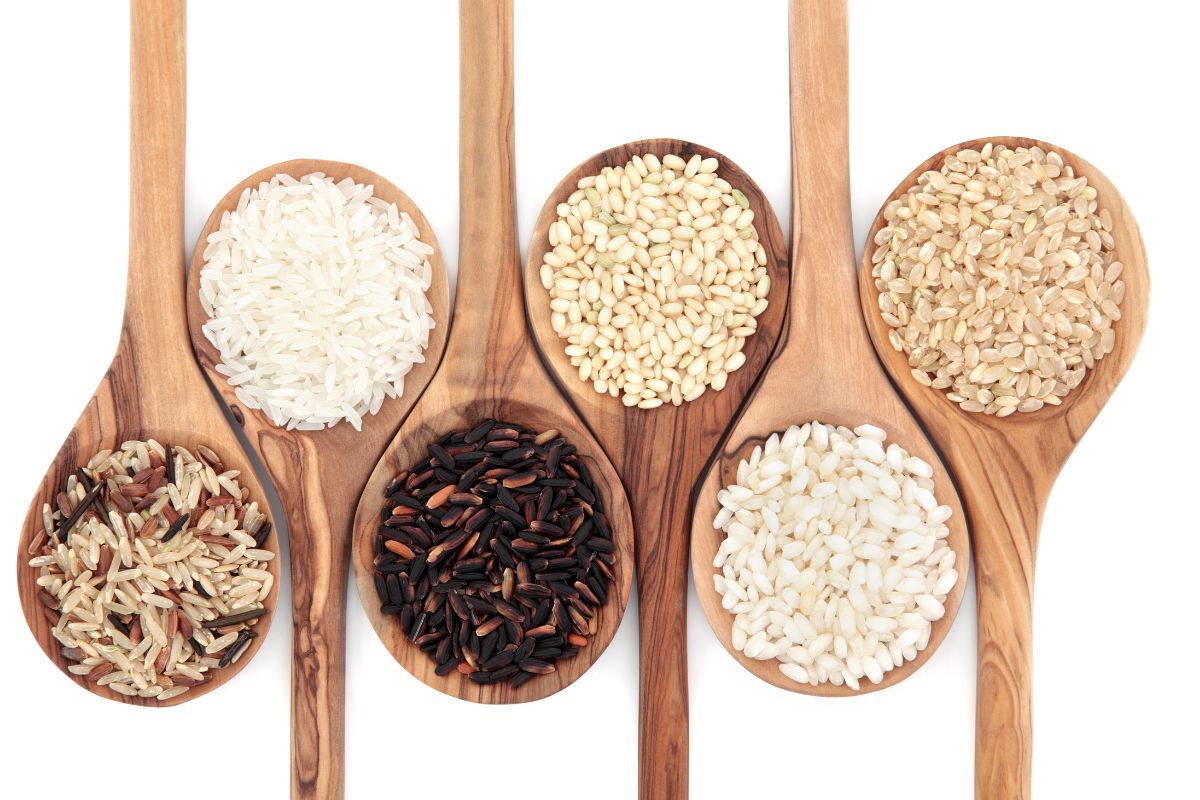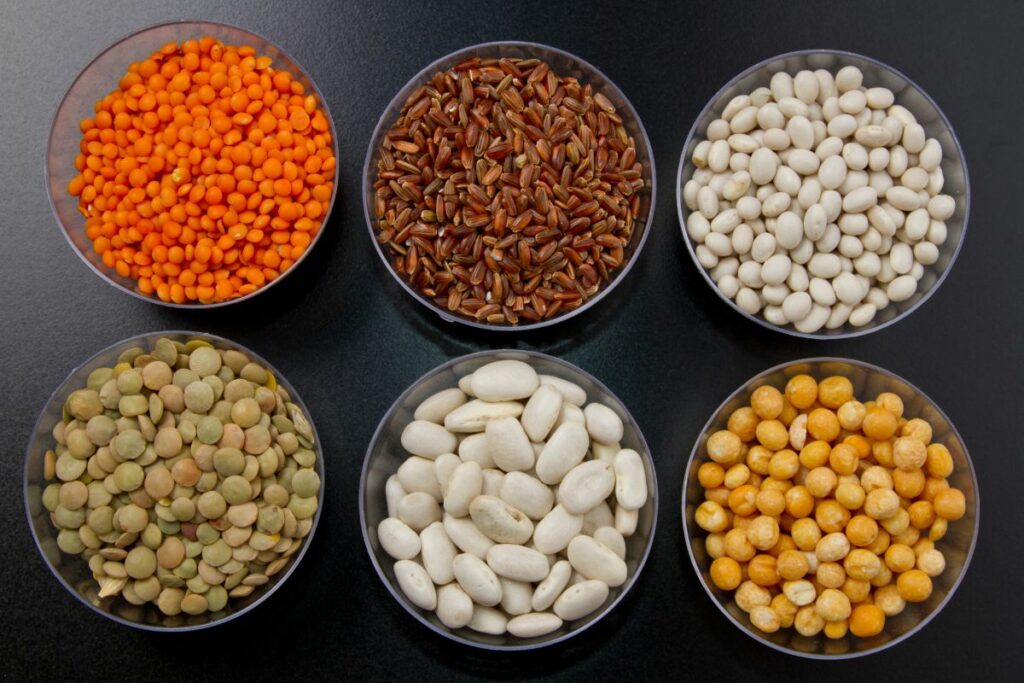As you pursue a whole food diet, it’s important to understand the different types of foods, what they are, and how to enjoy them. I grew up understanding what “rice” was because my mom made it all the time, but a “legume?” I think I first heard that word in junior high or high school science.
So first things first, is rice a legume? No, rice is not a legume. Rice is a grain, also commonly called a cereal grain, and belongs to the grass family (Poaceae). It is the seed of the plant species Oryza sativa (Asian rice) or Oryza glaberrima (African rice).
Legumes, on the other hand, are plants from the Fabaceae (or Leguminosae) family. Examples of legumes include beans, lentils, peas, and peanuts. Legumes are known for their ability to fix nitrogen from the atmosphere, which can improve soil fertility. They produce seeds in pods, which is a distinguishing characteristic of the family.
If you’re new to cooking rice or legumes, let’s get into some details so you can make the best food choices for you and your family.
What is a legume?
When you hear of foods referred to as legumes, it’s a plant that produce pods, revealing seeds inside.
They are grown naturally across the world and are eaten by both humans and animals as they are extremely nutritious. The pods can differ in size and length as they do not all look the same.

Here are some common legumes:
- Beans
- Black beans
- Kidney beans
- Pinto beans
- Navy beans
- Lima beans
- Chickpeas (or garbanzo beans)
- Mung beans
- Adzuki beans
- Fava beans (or broad beans)
- Lentils
- Green lentils
- Brown lentils
- Red lentils
- Black lentils (also known as beluga lentils)
- French green lentils (or Puy lentils)
- Peas
- Green peas
- Split peas (green and yellow)
- Snow peas
- Snap peas
- Black-eyed peas (or cowpeas)
- Peanuts: Despite their name, peanuts are legumes and not true nuts
- Soybeans: Used to make a variety of products including tofu, tempeh, and soy milk
- Alfalfa: Often used as sprouts in salads and sandwiches
- Clover: Commonly used as fodder for animals and can also be consumed as sprouts
- Lupins: Seeds from the lupin plant are sometimes eaten as a snack, especially in Mediterranean countries
- Mesquite: Used in some traditional foods and for its sweet pods
- Tamarind: The sour fruit pulp is used in cuisines around the world
- Carob: Often used as a chocolate substitute
These are just a few examples, and there are many more legumes consumed around the world, each with its unique taste, texture, and nutritional profile.
What is rice?
Rice is a staple food for a large part of the world’s population, especially in Asia. We usually think of rice as either “white rice” or “brown rice” and although these are common types of rice, the world of rice is much bigger.

Here are several types of rice based on grain size and characteristics, most of which are available in your local grocery store:
- White rice: This is the most common type of rice. It has had its husk, bran, and germ removed, which gives it a white color. It’s versatile and used in a wide range of dishes.
- Brown rice: Unlike white rice, brown rice retains its bran and germ, giving it a nuttier flavor and chewier texture. It’s more nutritious than white rice due to its higher fiber, vitamins, and mineral content.
- Basmati rice: Originating from the Indian subcontinent, basmati rice is long-grained and aromatic. It’s commonly used in Indian, Pakistani, and Middle Eastern cuisines, especially for dishes like biryani and pilaf.
- Jasmine rice: Native to Thailand, jasmine rice is fragrant and has a slightly sticky texture when cooked. It’s often used in Southeast Asian dishes.
- Arborio rice: This is a short-grain rice from Italy, known for its creamy texture when cooked. It’s commonly used in risotto and rice pudding.
- Wild rice: Not a true rice but a grass seed, wild rice has a chewy outer sheath and a tender inner grain. It has a nutty flavor and is often mixed with other rices or grains in dishes.
- Black rice (or Forbidden rice): Once reserved for Chinese royalty, black rice turns purple when cooked and has a sweet, nutty flavor. It’s rich in antioxidants.
- Red rice: This rice has a reddish-brown hue and a nutty flavor. It’s often eaten unhulled or partially hulled, which means it retains more nutrients.
- Sticky rice (or Glutinous rice): Despite its name, this rice does not contain gluten. It’s a type of rice that becomes very sticky when cooked. It’s commonly used in Asian desserts and dishes like mochi and mango sticky rice.
- Parboiled rice (or Converted rice): This rice has been partially boiled in its husk, which changes its texture and helps retain some of its nutrients. It’s less sticky than regular white rice and takes a bit longer to cook.
- Short-grain rice: This type of rice is almost round in shape and becomes sticky when cooked. It’s used in dishes like sushi.
- Medium-grain rice: Slightly longer than short-grain rice, it’s more tender and slightly sticky when cooked. It’s often used in dishes like paella.
These are just a few of the many types of rice available worldwide. Each type has its unique characteristics and is suited for different culinary applications.
Is it better to eat legumes over grains?
Both legumes and grains have their own nutritional benefits, and whether one is “better” than the other often depends on individual dietary needs, preferences, and health goals.
Legumes
- Protein content: Legumes, which include beans, lentils, and chickpeas, are a good source of plant-based protein. This makes them particularly valuable for vegetarians and vegans.
- Fiber: Legumes are rich in dietary fiber, which aids in digestion, helps stabilize blood sugar levels, and can assist in lowering cholesterol.
- Micronutrients: They are a good source of various vitamins and minerals, including iron, magnesium, potassium, and folate
- Low glycemic index (GI): Most legumes have a low glycemic index, which means they release sugar into the bloodstream slowly, providing sustained energy
- Health benefits: Regular consumption of legumes can help reduce the risk of chronic diseases like heart disease and type 2 diabetes
Grains:
- Carbohydrates: Grains, especially whole grains, are a primary source of carbohydrates, which provide energy for the body
- Whole grains vs. refined Grains: Whole grains (like brown rice, quinoa, and whole wheat) retain all parts of the grain, providing more fiber, vitamins, and minerals than refined grains (like white rice and white bread) (read more about the difference in “brown bread” and whole grains here)
- Micronutrients: Grains are a source of essential nutrients like B vitamins, iron, magnesium, and selenium
- Versatility: Grains are staple foods in many cultures and can be incorporated into a wide variety of dishes
- Digestibility: Some people may find modern grains harder to digest, especially those containing gluten. However, there are many gluten-free grain options available, such as rice, quinoa, and oats. You can also try whole grains that are much easier to digest, like einkorn or Kamut
Considerations:
- Dietary needs: Individuals with certain health conditions might prioritize one over the other. For example, someone looking to increase protein intake might opt for more legumes, while an athlete needing quick energy might prioritize grains
- Digestive health: Some people may experience digestive discomfort from consuming certain legumes due to their high fiber and FODMAP content. Similarly, individuals with celiac disease or gluten sensitivity must avoid gluten-containing grains
- Diversity: A varied diet is generally recommended for optimal health. Including both legumes and grains can provide a broader spectrum of nutrients
Here is a quick chart to help you make a decision on what is best for you and your family:
| Attributes | Legumes | Grains |
|---|---|---|
| Protein content | Legumes are a good source of plant-based protein, making them valuable for vegetarians and vegans. | Grains generally have lower protein content compared to legumes, but they still provide essential amino acids. |
| Dietary fiber | Rich in dietary fiber, which aids in digestion, helps stabilize blood sugar levels, and can assist in lowering cholesterol. | Whole grains are a good source of dietary fiber, while refined grains have less fiber due to processing. |
| Micronutrients | Good source of various vitamins and minerals, including iron, magnesium, potassium, and folate. | Grains provide essential nutrients like B vitamins, iron, magnesium, and selenium. Whole grains retain more nutrients than refined grains. |
| Glycemic index (GI) | Most legumes have a low glycemic index, providing sustained energy by releasing sugar into the bloodstream slowly. | Depends on the type of grain. Whole grains generally have a lower glycemic index than refined grains. |
| Health benefits | Regular consumption can help reduce the risk of chronic diseases like heart disease and type 2 diabetes. | Whole grains have been associated with reduced risk of heart disease, obesity, and certain types of cancer. |
How to eat more legumes and grains
Incorporating more legumes and rice into your diet can be both delicious and nutritious. Here are some strategies and ideas to help you eat more of these foods:
1. Start with familiar dishes
- Rice: Begin with dishes you already enjoy that use rice as a base, such as stir-fries, curries, or casseroles.
- Legumes: Add beans or lentils to salads, soups, or pasta dishes you already make.
2. Experiment with different varieties
- Rice: Try different types of rice like basmati, jasmine, wild rice, or brown rice to add variety to your meals.
- Legumes: Explore various beans (black beans, kidney beans, chickpeas), lentils (green, red, brown), and other legumes like peas or edamame.
3. Make them a main dish
- Rice bowls: Top cooked rice with a mix of vegetables, protein (tofu, chicken, beef), and a flavorful sauce.
- Bean or lentil stews: Cook legumes with vegetables and spices to make hearty stews or soups.
4. Use in salads
- Mix cooked and cooled rice with veggies, a protein source, and dressing for a filling rice salad.
- Add beans or lentils to green salads for added protein and texture.
5. Snack on them
- Roasted chickpeas: Season and roast chickpeas in the oven for a crunchy snack.
- Rice cakes: These can be topped with avocado, peanut butter, or other spreads for a quick snack.
6. Incorporate in breakfast
- Rice pudding: Make a sweet or savory rice pudding for breakfast.
- Legume-based spreads: Use hummus (chickpea spread) or other bean spreads on toast.
7. Use as a meat alternatives
- Bean or lentil burgers: Make patties using mashed beans or lentils, breadcrumbs, and seasonings.
- Rice and beans: A classic combination in many cultures, providing a complete protein source.
8. Add to baked goods
- Black bean brownies: Incorporate pureed black beans into brownie recipes for added nutrition.
- Lentil muffins: Add cooked and mashed lentils to muffin batters.
9. Preparation tips
- Soak legumes: Soaking beans and lentils overnight can reduce cooking time and improve digestibility.
- Batch cook: Cook a large batch of rice or legumes and freeze in portions. This makes it easy to add to meals throughout the week.
10. Educate yourself
- Learn about the health benefits of legumes and rice, which can motivate you to include them more often.
- Explore recipes from cultures that traditionally consume a lot of legumes and rice, such as Indian, Mexican, or Middle Eastern cuisines.
11. Mix with other grains
- Combine rice with other grains like quinoa, barley, or millet for a varied texture and flavor.
12. Dips and spreads
- Make dips like hummus, bean dip, or lentil spread to use with crackers, bread, or veggies.
Remember, the key is to start slowly and gradually increase your intake. As you experiment with different recipes and preparations, you’ll find enjoyable ways to make legumes and rice regular staples in your diet.
Conclusion
No matter what you choose for a meal, both rice and legumes are nature-made food that adds great variety to your diet. Eating both ensures that you can have a balanced diet, full of vital nutrients that you and your family needs to be healthy.
Don’t be afraid to try new varieties of rice or legumes as you might be pleasantly surprised with what you discover.








